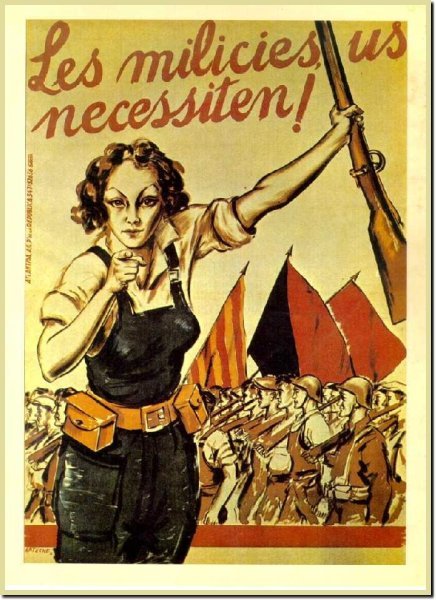THE IDEA FACTORY: Military Units
 •
by
•
by Silas Soule
THE IDEA FACTORY: Military Units
Subcomandante Bunny

sez...
The following is on finding balance within eRepublik's social ecosystem, with attention to the military module, particularly the organization of militia units.
Big thanks to Samuel Seabury for inspring this article! The "How to Lead" section is pretty much just an edited-down version of this article by Sam. I'd also point out that that advice applies to more than just military organization, but I find that it is particularly relevant in this context.

"Ursa Fi!", battle cry of the Men Who Ride on Bears
As you may or may not know, the SFP's legendary Bear Cavalry is back in operation under the command of that outstanding proletarian internationalist, Alex Drex. Ursa Fi! Bears for-evah! The Bears have been criss-crossing the world lately fighting for freedom and independence against the imperialist onslaught of the ONE alliance.
Right. Anyway, there's an economic element to supporting a self-sustaining militia, as well as a political one, but I'll get to that stuff another time. What I want to focus on here is thinking about finding balance within a military or militia structure.
There's a couple of elements to this, I think. The first has to do with how commanders relate to soldiers; the second has to do with how soldiers relate to the militia organization.
On that first point -- how commanders relate to soldiers -- the SFP Bear Cavalry kinda takes its cue from the RL Spanish anarchist brigades during the Spanish Civil War, like the Durruti Column, where titles were meaningless except to serve a functional purpose: primarily to convey marching orders. In other words, there is a hierarchy, but it carries no privileges. Much like the SFP as a whole, bureacracy is kept to a minimum and grandiose titles are frowned upon.

The militia needs you!
On the second point -- how soldiers relate to the organization -- I think it's fair to say that we've improved on our experinece. The Bear Cavalry used to be strictly egalitarian when it comes to distributing weapons and other supplies. It even had a policy against "tanking" in order to prevent to widening of class differences within the militia.
In its current form, the Bear Cavalry has a more nuanced, and I would say stronger, position on empowering soldiers. It is still egalitarian, but now puts more emphasis on developing the abilities of each fighter. For one thing, all our weapons are Q5's now, which helps. And although we still discourage the development of a system that rewards elitism, we do encourage each partisan to build up his or her strength as much as possible by only delivering weapons to fighters who (a) work in the militia commune and (b) use as much of their 300 wellness recovery as possible each time they fight.
It's basically a fair exchange system. Work for the collective and fight to the max of your ability: you'll get plenty of food and Q5 weapons. Slack off or just come begging for handouts: not so much.
But perhaps the most important element of finding balance within a military unit is putting the right focus on creating an environment that encourages leadership at every level.
HOW TO LEAD

I like to joke around a lot about "great teacher-leaders". That's because the whole idea of relying 100% on "great leaders" is a little bit ridiculous. The following text, based on this article from the New Zealand Policy Reform Caucus, outlines what real leadership is.
The SFP Bear Cavalry, like the Socialist Freedom Party as a whole, is interested in continually producing a generation of leaders: players who know themselves and can find their own way through the New World while setting an example for and inspiring others.
So what is leadership? And how is it exercised?

Leadership provides purpose, direction and motivation. A good leader is defined by what she is, what she knows and what she does.
Be...
- Technically and tactically proficient.
- Loyal to your principles, a person of integrity.
- Respectful to all, a person who has empathy for others.
- Hard-working, honorable and courageous.
Know...
- Yourself and constantly seek self-improvement.
- Your volunteers and colleagues.
- What works and what doesn't work.
- What your work unit, your fighting unit, your party, your friends and your community need.
- How to listen actively.
Do...
- Lead by example. Don't wait to be told what is the right thing to do.
- Keep those around you informed. Don't assume everybody has the same information.
- Demonstrate that you care for people as people, not only as players.
- Ensure that tasks are understood and that people are accountable.
- Train as a team and develop a collective sense of responsibility.
- Make sound and timely decisions.
- Deploy commands only in accordance with the capabilities of your role.
- Seek responsibility and take responsibility.
- Keep and enforce high standards
- Encourage initiative, critical thinking and continual improvement.
When all is said and done, being a leader is not about you; it is about the people that you lead.
Leaders are like good teachers: they are fair, but push people to do their best. They bring out the best in other people, not by lecturing but by drawing on what "students" already know and encouraging them to help "teach the class".
Excercising leadership typically requires a combination of authoritarian and democratic techniques. Knowing which are needed in specific situations is the hallmark of a successful leadership environment.
Leadership Techniques

- Pressure. Deadlines and frequent check-ups. Use it when stakes are high and time is short.
- Lawful orders. Using the authority of an office. There should be consequences for failing to follow the legitimate request of a lawful order.
- Exchange. Offering an item or action in exchange for complying with a request. Being able to follow through on the exchange is, of course, critical when exercising this type of influence.
- Personal appeal. Use this in a difficult situation when mutual trust is the key to success. Highlight special talents or professional trust that are based on friendship, loyalty and mutual respect.
- Collaboration. Make choices more attractive by stepping in and solving a problem that requires going outside of the established chain of command.
- Rational persuasion. Use evidence, logical arguments or explanations relevant to the goal. Often a good first step towards gaining a commitment, this technique is often combined with showing by example.
- Aspiration. Explain why a request benefits the other. Different from Exchange because you do not control the outcome, so be careful to consider whether the promised benefit is credible.
- Inspiration. Arouse strong emotions to build up conviction. Overuse leads to burnout, so use sparingly for the most critical situations.
- Participation. The most important democratic technique. Ask others to help resolve a problem or meet an objective. Requires more time and effort because it implies consensus.
- Relationship building. Build up mutual trust and a positive rapport. Show interest in the well-being others, offer praise, work to understand the perspective of others. While this does not bring about short-term benefits, it is crucial to team cohesion.
One Bullet Away

One Bullet Away: The Making of a Marine Officer is book by Nathaniel Fink, a former Captain in the First Reconnaissance Batallion, USMC. It provides a personal account of how many of the leadership qualities outlined above are inculcated in real life. Whether you're an e-social-anarchist or proud to be an e-imperial grunt, there's some good food for thought in it. The evocative title means that, whatever position you hold at present, when you're in battle you're always potentially in a position to have to take the lead, so be prepared.
*******
You can always delegate authority. But you should never delegate responsibility. Leadership means taking responsibility for your own actions as well as the actions of others. Real leaders never shift the blame for their own mistakes onto others.
Leadership is not only about a formal chain of command. Especially in a Volunteer organization, informal leadership is equally important. Informal leadership occurs as an individual exerts influence on others for the good of the organization.
This cannot be emphasized enough. Battle orders may not always be up-to-date... a fellow Volunteer may need help understanding when is the best time to fight... an officer may be called away from the game to address real-life concerns... a sudden opportunity may arise to advance the cause... such things require leadership skills at every level.
At the end of the day, leadership is not about giving orders -- though that is one aspect -- it is about seeing what needs to done, doing it, and getting others to join you. Teach what you know and you too will be a leader.

Well, that's all my pontificating for today. (Whew!)
Please comment and share your own ideas and experiences on how to find the right balance within a military or militia unit.
And, of course, don't forget to vote, subscribe, link-to and shout about this article. Those media mogul awards don't just win themselves, you know. LOL
xio, PQ

Freedom Writer


Comments
Freedom!
Great as always ; p
How to Lead ftw
Damn. Fine. Voted.
tl;dr honestly
simply seeing the forest for the trees
as always, stellar PQ
Nice info and good writing as always...
anan zaaaa
ts;dr xD
"You can always delegate authority. But you should never delegate responsibility."
Absolutely perfect. Thank you for writing this.
--Fit
Bananarama;Ramanana.
One who refuses to read is no better than the one who can't.
Thanks for the plug, but I'm also indebted to Dandridge (Mad Mike) Malone and many other fine RL officers for teaching me what little I know about leadership. One of the important elements of leadership is to take responsibility for oneself. Even if you are not in a militia, or a military unit, you can apply many of the principles PQ lays out. For example - how much are you prepared to spend of your own money to fight ? Where do you fight, and how does it make a difference ? I wrote the original "How to Fight" articles at the height of V2, but the same general questions remain on how to organize for battle. Always remember that Hope is Not a Plan.
wow - many sources. You did your homework ; )
❤️ >>>>> https://www.youtube.com/redirect?q=%64%61%74%65%34%66%75%71%2e%63%6f%6d%231755868
❤️ >>>>> https://www.youtube.com/redirect?q=%64%61%74%65%34%66%75%71%2e%63%6f%6d%231755868